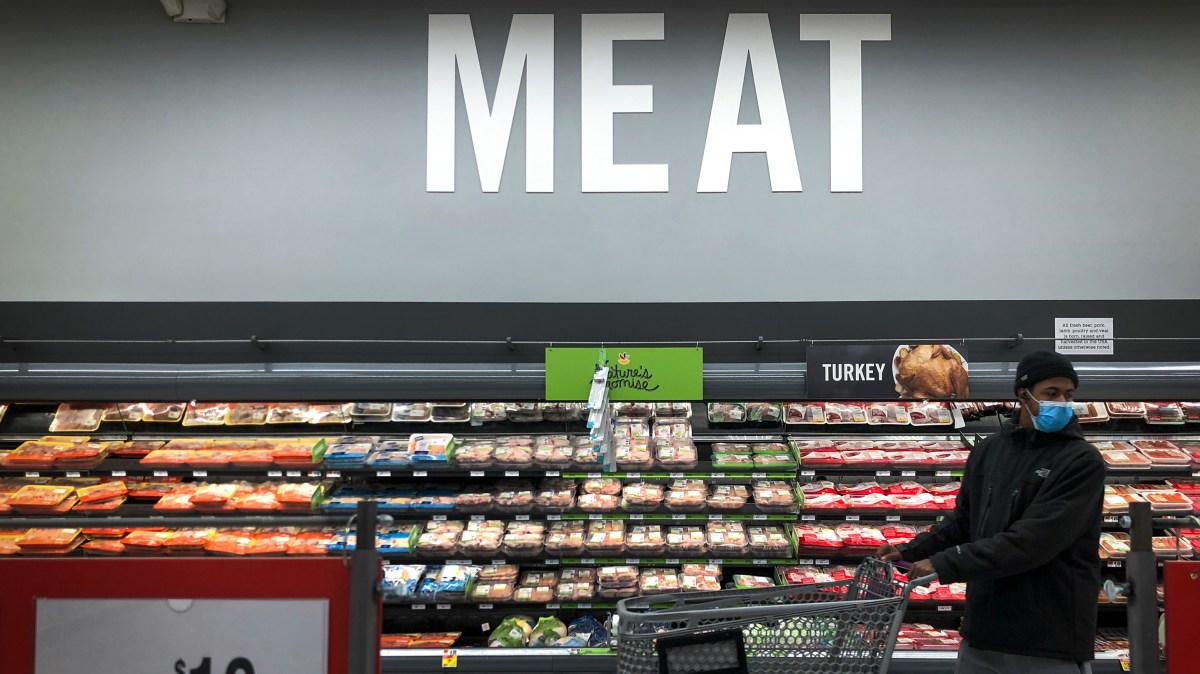
Just a few months ago there were meat shortages around the country as packing plants shut down due to COVID-19 outbreaks. Grocery stores were limiting purchases, and meat prices were soaring.
Now, we’ve got more meat than people may be able to eat. The surplus has been building for months as restaurants, hotels and other businesses that feed people remain closed or are only partly open.
When most of us started staying home in March, there was an immediate surplus of meat. Cafeterias, airports, arenas were mostly closed or barely open.
“Think of how much food was consumed in a football stadium on a Sunday with 70,000 people in it,” said Chris Muller, a hospitality consultant and former Boston University professor. That meat is distributed differently than the meat we typically buy in supermarkets.
So that meat was repackaged and sent to grocery stores. But it turns out people don’t eat the same stuff at home as they do when they go out.
Then, meatpacking plants closed down when workers got sick. That left livestock lingering on farms and feedlots.
“Now that we’ve gotten the production levels back up to normal, we have to process those materials for meat production because there’s really no other way that we could repurpose that livestock,” said Terry Espers, professor of supply chain management at Ohio State University.
So now there is more meat at lower prices, and not just in supermarkets.
Before the pandemic, Michelle Durpetti, who manages Chicago steakhouse Gene and Georgetti, was spending around $31 a pound for a steak filet. Now it’s down to about $24 a pound.
“In normal times, this would be a much different discussion, because anytime meat prices drop and you can still do the volume, that’s a good thing,” Durpetti said.
Right now, her two restaurant locations are open, but she isn’t doing the volume; she’s buying 75% less meat than she was before the pandemic.
What’s going on with extra COVID-19 unemployment benefits?
It’s been weeks since President Donald Trump signed an executive memorandum that was supposed to get the federal government back into the business of topping up unemployment benefits, to $400 a week. Few states, however, are currently paying even part of the benefit that the president promised. And, it looks like, in most states, the maximum additional benefit unemployment recipients will be able to get is $300.
What’s the latest on evictions?
For millions of Americans, things are looking grim. Unemployment is high, and pandemic eviction moratoriums have expired in states across the country. And as many people already know, eviction is something that can haunt a person’s life for years. For instance, getting evicted can make it hard to rent again. And that can lead to spiraling poverty.
Which retailers are requiring that people wear masks when shopping? And how are they enforcing those rules?
Walmart, Target, Lowe’s, CVS, Home Depot, Costco — they all have policies that say shoppers are required to wear a mask. When an employee confronts a customer who refuses, the interaction can spin out of control, so many of these retailers are telling their workers to not enforce these mandates. But, just having them will actually get more people to wear masks.
You can find answers to more questions on unemployment benefits and COVID-19 here.
As a nonprofit news organization, our future depends on listeners like you who believe in the power of public service journalism.
Your investment in Marketplace helps us remain paywall-free and ensures everyone has access to trustworthy, unbiased news and information, regardless of their ability to pay.
Donate today — in any amount — to become a Marketplace Investor. Now more than ever, your commitment makes a difference.
tinyurlis.gdv.gdv.htu.nuclck.ruulvis.netshrtco.detny.im
مقالات مشابه
- شرکت صادرات و واردات کالاهای مختلف از جمله کاشی و سرامیک و ارائه دهنده خدمات ترانزیت و بارگیری دریایی و ریلی و ترخیص کالا برای کشورهای مختلف از جمله روسیه و کشورهای حوزه cis و سایر نقاط جهان - بازرگانی علی قانعی
- نرخ وام مسکن امروز, آوریل 4 سال 2020 به همراه قفل توصیه
- ترفند های خانه داری و زندگی - راهنمای باهوش
- ترفند های زندگی و خانه داری - متخصص ترفند های زندگی
- یادگیری برنده شدن مشتریان و تأثیر فروش ناخالص با قلعه بادی
- شرکت صادرات و واردات کالاهای مختلف از جمله کاشی و سرامیک و ارائه دهنده خدمات ترانزیت و بارگیری دریایی و ریلی و ترخیص کالا برای کشورهای مختلف از جمله روسیه و کشورهای حوزه cis و سایر نقاط جهان - بازرگانی علی قانعی
- شرکت صادرات و واردات کالاهای مختلف از جمله کاشی و سرامیک و ارائه دهنده خدمات ترانزیت و بارگیری دریایی و ریلی و ترخیص کالا برای کشورهای مختلف از جمله روسیه و کشورهای حوزه cis و سایر نقاط جهان - بازرگانی علی قانعی
- واشنگتن NFL تیم حذف ردسکینز نام و آرم
- بازار مسکن نشان می دهد نشانه هایی از گرم شدن
- آن را امن برای دیدن دکتر خود بیمار بهداشت و درمان صنعت می گوید آینده نگر بیماران